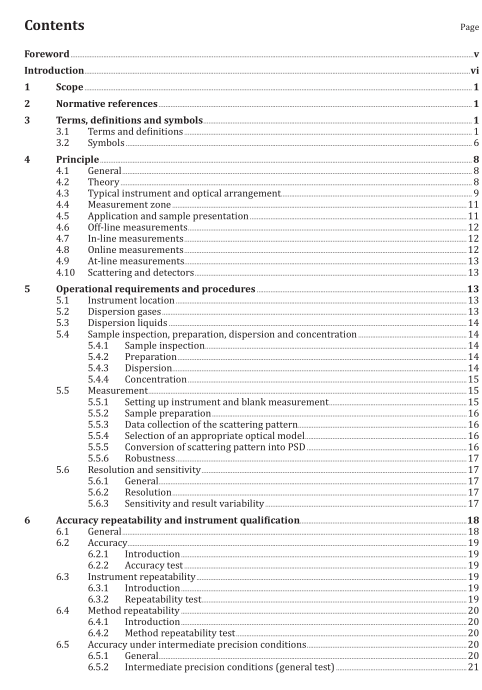ISO 13320:2020 pdf download.Particle size analysis — Laser diffraction methods
4 Principle
4.1 General The laser diffraction or scattering technique 1) for the determination of particle size distributions, PSDs, is based upon the phenomenon that the angular distribution of the intensity of scattered light by a particle (scattering pattern) is dependent on the particle size. When the scattering is from a cloud or ensemble of particles the intensity of scattering for any given size class is related to the number of particles and their optical properties, present in that size class [5][20] . A test sample, dispersed at an adequate concentration in a suitable liquid or gas, is passed through the beam of a monochromatic light source, usually a laser. The light scattered by the particles, at various angles, is measured by an array of photo detectors.
The numerical values from each detector are recorded for subsequent analysis. Within certain limits, such as of particle concentration in measuring zone, the scattering pattern of an ensemble of particles is identical to the sum of the individual scattering patterns of all particles.
The theoretical scattering patterns of unit volumes of particles in selected size classes are used to build a matrix and together with a mathematical procedure are used to solve the inverse problem, providing a volumetric particle size distribution (PSD), iterated to provide a best fit to the measured scattering pattern [18] .
4.2 Theory
The theoretical scattering pattern of a single spherical homogeneous particle is given by Mie-theory in general [4] . If the particle size is relatively large (in terms of size parameter, α = π × n m /λ > 10) and is opaque, Fraunhofer diffraction theory is available only for small angle forward scattering [4][5] . The Fraunhofer approximation is an analytical method that does not require the optical properties of the material. Some other theoretical approximations are available for numerical realization of the Mie-theory, and these are called optical models in general. Choosing a relevant optical model for the inverse problem to yield a proper PSD is important. Laser diffraction records the scattering pattern from the particles presented.
This composite pattern is converted to a size distribution of spherical particles that would provide the same composite scattering pattern using an appropriate optical model and data inversion routine. It therefore provides a size distribution of laser diffraction equivalent spheres. If the test sample is not spherical, the same basic procedure is used and the resulting size distribution is formed. Thus, PSD’s for non-spherical particles are likely to be different from other particle sizing techniques measuring the same material. The details of the theory are given in Annex A.
4.3 Typical instrument and optical arrangement
The system consists of a monochromatic light source, sample feeder, optical system, light detectors, and control-calculation device. To extend the applicable range of particle size and its analysis, multiple
light sources, additional light detecting systems and related optical systems can be used.
The light source is typically a laser or other narrow-wavelength source to generate a monochromatic beam. This is followed by a beam-processing unit producing an extended and nearly ideal, Gaussian distributed beam to illuminate the dispersed particles. The illuminating light beam passes through the measuring zone of the optical system.
A computer is used to control the measurement, to store and to process the data, and to solve the inversion problem from the data of the detected signals to the particle size distribution. It may provide automated instrument operation.
Typical diagrams of the set-up of laser diffraction/scattering instruments are given in Figures 1 to 4.
4.4 Measurement zone
The locations of the two possible measurement zones, are illustrated in Figures 2 and 4. The Fourier optical arrangement allows, within certain limits, the particles to traverse the beam in a wide range of positions along the laser axis. By contrast, the presentation of particles within the reverse Fourier optical arrangement shall be confined to a short distance along the laser axis if errors in sizing are to be avoided. The measurement zone shall be located at a defined distance from the low angle detector.ISO 13320 pdf download.ISO 13320 pdf download
